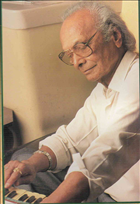


It is always painful to watch a legend depart and composer Naushad’s demise was one such poignant moment. His old age and frail health finally accepted defeat and the man - long regarded as an epoch-making composer in the annals of Hindi film music, breathed his last on May 5, 2006.
Watching some major TV channels dishing out hurriedly compiled tributes which sometimes confused him with another composer Nashaad and sometimes credited him with movie- scores he didn’t compose, I just winced in a state of angry helplessness. This so-called informed TV coverage for today’s masses was simply clueless about the great man’s musical contribution. But then they were just doing their job and there I was lamenting the loss of a legendary composer whose songs had provided some of the most magical musical moments in my life!
A perfectionist at work
In a career spanning over more than six decades, Naushad composed for just 75 films (out of that 65 were Hindi films) but then he was always regarded as the choosiest composer. Taking days to finalize one tune, he was also regarded as the slowest! As the pace of life went on quickening with each passing decade, such perfectionist attitude might have slowly made him redundant, but that very steadfast attitude also helped him compose many a masterpiece.
Beginning his career as an assistant for music directors like Mushtaq Hussain Khan, Khemchand Prakash and Manohar Khanna, a young Naushad composed his first independent movie-score for Prem Nagar in 1940. In the initial years, he relied more on simple yet catchy rhythmic melodies. Listening to scores like Rattan (1943), Shah Jehan (1946) and Anmol Ghadi (1946) this simplistic popular appeal of tunes like Ankhiya Milake Jiya Bharmake, Ghum Diye Mustakil and Jawan Hai Mohabbat is well evident.
1952-film Baiju Bawra marked watershed in his career. From then on he consciously decided to work within the framework of Indian classical and folk-music. Thus he created many milestone raga- based songs like Man Tarpat Hari Darshan Ko (Raga- Malkauns), Madhuban Mein Radhika Naache Re (Raga- Hameer), Mohe Panghat Pe (Raga- Gara) and Mohe Bhool Gaye Sawariya (Raga- Bhairav) and also some brilliant folk-songs like Nain Lad Jai Hain and Dukh Bhare Din Beete Re Bhaiya. This total reliance on indigenous Indian music was Naushad’s strength and later sadly it also proved to be his limitation.
The latter years
1960s brought in the rock-n-roll influence on Hindi film music and even the great Naushad had to unwillingly try and westernize his music. Saathi was one such ‘compromised’ score. But his heart wasn’t into it and that showed. The subsequent years saw his career go downhill- both in terms of quality and commercial appeal. In the rat-race of plagiaristic composers willing to stoop to any level to succeed, an original like Naushad was a misfit. That’s why for most of his latter years, he just remained as an icon always there to be exemplified and celebrated for his unique Indian-ness but who held no real-time relevance in the rapidly changing and deteriorating musical scenario.
Thankfully in his last year he could at least offer a glimpse of his musical genius to present generation with a refurbished digital score for Mughal-e-Azam’s coloured version and some melodious music for Akbar Khan’s Taj Mahel. In a way, it was poetic justice that the score for this opulent Mughal-era epic was to be the swansong from this last Mogul of Hindi film music!
Fact File:
Some Top Songs